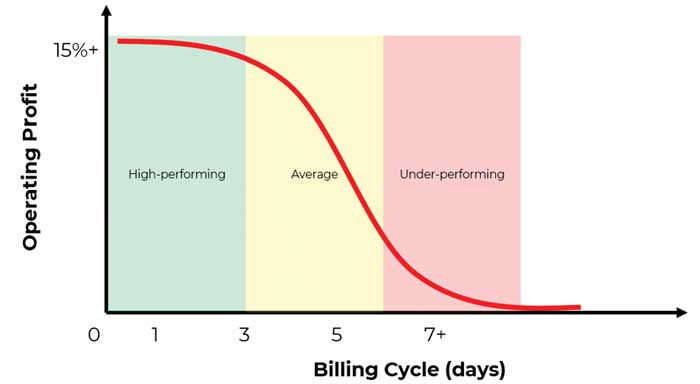Airspeed.
Pilots live and breathe by the dial that indicates the speed at which their aircraft slices through the air. The airspeed indicator is the most crucial flight instrument for any pilot. It’s both the ultimate measure of performance — think Top Gun’s Maverick: Mach 10, we’ll give them Mach 10 — and safety — ask any pilot. As the old saying goes, “Airspeed is life, attitude is insurance.”
The billing cycle — or the duration between the technician’s last labor punch and customer invoicing — is your airspeed for service sales. Whether you’re piloting your dealership and service business to new levels of profitability (performance) or bouncing through the thermals of turbulent times (safety), use the billing cycle as your leading indicator of service performance.
Leading & Lagging Indicators
Measuring the performance of your service department is easy, right? Not so fast. Measuring what matters is most important. Are you measuring and influencing (daily) the things that count or simply assessing an outcome? Unfortunately, far too many dealer leaders spend their time focused on the wrong measure with little to no ability to affect change in the result.
In business, there are 2 types of measures or indicators: Leading and Lagging.
- Leading indicators manage performance and are often time-based, influenceable on a near-daily basis, and relatively easy to measure once you determine what it is you need to measure. For example, in the service department, leading indicators include technician productivity/efficiency, response time and the billing cycle.
- Lagging indicators measure performance, are less influenceable and can be more challenging to calculate (particularly for financial indicators). For example, in the service department, lagging indicators include customer satisfaction scores, absorption and profitability.
Consider the difference between the two. By the time you measure profitability, you’ve already completed the repair (and any necessary rework) on the customer’s machine, allocated technician time, returned parts and paid your operational expenses.
So, profitability is a lagging outcome. Nevertheless, it’s a measure of where your business has been.
Conversely, billing cycle is a leading measure that indicates where your business is going.
Billing Cycle: The Right Measure
The billing cycle is a simple but not simplistic measure of service department performance. It is a time-based measure, indicating the duration of elapsed time, usually in days, between a technician’s last labor punch on a job code or segment and the point at which the repair or work order is closed.
What’s remarkable about the billing cycle is that it accurately reflects the overall health of your service business and ability to operate profitably.
Operational efficiency? Check.
Is your process smooth, with few delays and unnecessary hierarchical approvals? A low billing cycle indicates that you’ve achieved high operational efficiency and process consistency.
Employee engagement? Check.
Are tasks repetitive, or do problems continually repeat themselves? A high billing cycle is a warning sign — your team is likely frustrated and seeking a better way. Help them!
“The billing cycle accurately reflects the overall health of your service business…”
Customer satisfaction? Check.
Your customers are much happier and more likely to pay their invoices on time when billed promptly after their service is complete.
To give you an idea of the general relationship between billing cycle and profitability (exceptions notwithstanding), check out the graph above. So, how do you rate the performance of your service business?
3 Steps to Improvement
This 3-step process will improve your billing cycle today.
Step 1: Apply the 3D’s: Document, Display and Discuss the measure. Your billing cycle is not like a fine wine: it doesn’t improve with age, nor does it offer any value if you hide it. So measure it, make it visible to your entire service department, and discuss it daily during your 5-minute morning meeting.
Step 2: Physically walk through your billing cycle process and note what’s working, what isn’t and what needs improvement. Like Maverick following the waypoints before dropping his payload, you must follow the trail of paper or data. Step 2 is essential to understand today’s reality in your dealership. Start with the technician and follow the work order to the end of your process when the customer is invoiced.
Consider asking open-ended questions like:
- What is working well now?
- What must be fixed?
- What needs to be improved?
- What happens when…
- If you could change one thing…
Step 3: Implement incremental improvements. Think about what it must take to pilot a 777, an aircraft with an operating weight of nearly 500,000 pounds. The pilot must know where they’re headed and make precise, controlled and systematic flight control inputs to achieve the desired heading, altitude and airspeed. Like the organizational inertia in your business, the plane’s inertia demands that the pilot evaluate the outcome of their inputs before making further changes.
The same applies to your service department.
As you identify and make changes to your billing cycle process (for example, the completeness of technician work order 3C’s: complaint, cause, correction), evaluate the effects of one change and implement it fully. Ensure plenty of communication about why the change is happening before making further changes.
Steve Jobs famously said, “If you keep your eye on the profit, you will skimp on the product. But if you focus on making really great products, then profits will follow.”
Provide your customers with a great service experience — the product — measured by the billing cycle, and profitability will surely follow.







